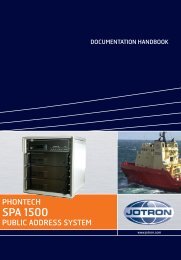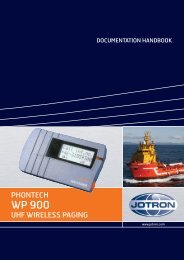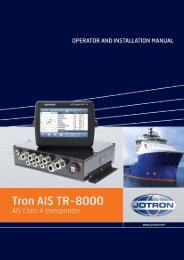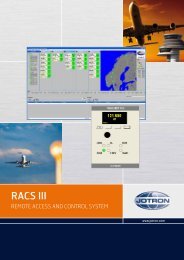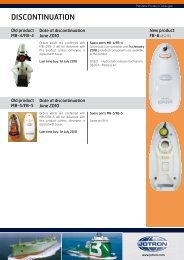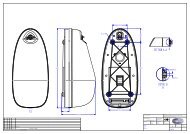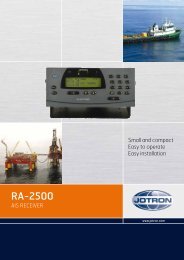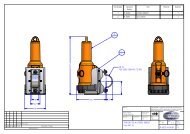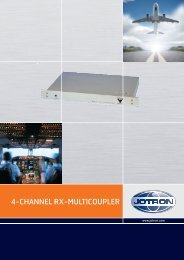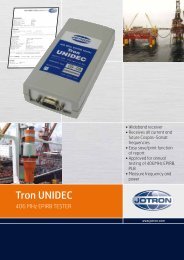Create successful ePaper yourself
Turn your PDF publications into a flip-book with our unique Google optimized e-Paper software.
www.jotron.com<br />
curs till the rescue forces are at the site. Each emergency EPIRB in the system<br />
is programmed with its own unique code, therefore it is vital that the ships data<br />
that is given to the dealer you obtained your <strong>Tron</strong> S-<strong>VDR</strong> <strong>CAPSULE</strong>, is correct.<br />
If the EPIRB is programmed with serial protocol, it is important that the EPIRB is<br />
registered in the database for each country. This database is normally located<br />
in the same country that the ship is registered.<br />
1.1.2 SIGNAL DETECTION<br />
When the EPIRB is activated (manually or automatically) it transmits on the frequencies<br />
121.5MHz and 406.028MHz.A homing signal is emitted on 121.5MHz<br />
and a burst is transmitted on 406.028MHz every 50 second after activation.<br />
This burst contains all necessary information about the ships in distress. After<br />
the EPIRB is activated, the next passing satellite will detect the transmitted<br />
signal and relay it to an antenna at a ground station, called a LUT (Local User<br />
Terminal). For the 121.5MHz signal the satellite must be within line of sight of<br />
both the EPIRB and a ground station.<br />
The ground station or LUT has a 2500 km satellite reception radius centered<br />
at the LUT. In areas without LUT coverage (mostly less populated areas<br />
in the southern hemisphere), signals from the 121.5MHz transmitter will not be<br />
detected by the satellites, only by passing aircraft’s. From the year 2006,no<br />
new satellites will be launched including 121.5MHz receiver, and from the year<br />
2009,satellitedetection of the 121.5MHz EPIRB is terminated. This is not the<br />
case with the 406MHz transmitter, because the satellites have a memory unit,<br />
which stores the signals for relay to the next available LUT giving it a truly global<br />
coverage. Once the signal is received by the LUT, it is processed for location<br />
and sent to a Mission Control Center (MCC).The MCC sorts the alert data according<br />
to geographic search and rescue regions and distributes the information<br />
to the appropriate Rescue Co-ordination Center (RCC), or if outside the national<br />
search and rescue area, to the appropriate MCC that covers the area that<br />
the distress signal was detected. The RCC in turn takes the necessary action to<br />
initiate search and rescue activities.<br />
1.1.3 DISTRESS LOCATION DETERMINATION<br />
The location of the distress signal is determined by taking measurements of the<br />
doppler shift of the EPIRB frequency when the satellite first approach and then<br />
pass the EPIRB. The actual frequency is heard at the time of closest approach<br />
(TCA). Knowing the position of the satellite and using the received doppler signal<br />
information, it is possible to determine the location of the Capsule from the<br />
82310_UM_S<strong>VDR</strong>_H<br />
15



